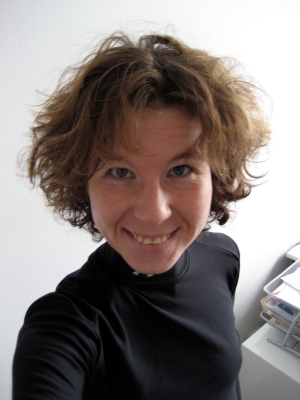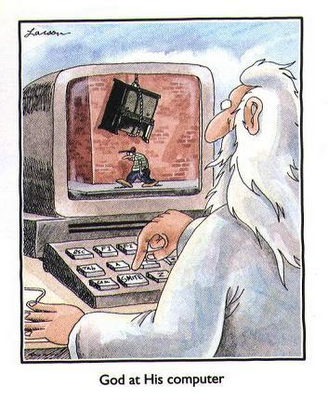Bee has asked me to talk about why I have chosen theoretical physics, and I am grateful to have the chance to oblige. However, I must ask for your patience because I couldn't explain why without telling you how I came to understand why, so this is written as a narrative. And begin:
A lot of physicists, whatever religious identification they take for themselves, take the opportunity afforded by the Christmas, neé "Winter Holiday," season to go home or travel to warmer climes. Even with the stress of family, people take the time to relax and read a silly book, perhaps something by Dan Brown about physicists. Me? Not only did I not go home to my hometown of Los Angeles, but I actually stayed in Waterloo, Ontario, a considerably colder location! I far surpassed the Dan Brown readers out there, gorging myself on episodes of Grey's Anatomy and Radio Free Roscoe. I was on a self-imposed and very strict break from thinking about physics so that I could think about something else: doing physics.
Before you ask, these two things are not the same. In the same way we might recall the stereotype of the distinction between the one who does and the one who merely dreams about it, I felt that for the last 14 years, I had been maybe living on the fence between the two. Ironically, right about this time, Bee asked me if I would write an entry for her blog about why I do theoretical physics. I told her I would, although I was petrified I was going to end up writing some pretty lies for everyone: inspiration that sounds good but really had done nothing for me. It is my hope that I have side-stepped inspirational-drivel and have instead managed to offer my version of the truth about what it means to do physics.
For the last decade and a half, I have really enjoyed telling the story of how my mom dragged me to see a doc about Stephen Hawking when I was 10, completely against my will, and how sometime during that viewing, a light came on for me. Something similar to Priests who say they "get the call." Luke Skywalker discovering his way with the force. It was definitely a mythical feeling that insisted that I have a copy of Hawking's book immediately as well as plan out my entire career, which I did: an undergraduate degree from Caltech or Harvard (the latter turned out to be the case) and a Phd from Cambridge. (who knew it was so expensive to attend school in England for a USAmerican?) From there, I would continue into a glorious career that would involve discovering the true physics that would eliminate singularities and explain both black holes and the Big Bang.
This is probably one of the reasons that we probably shouldn't let ten year olds run the world: oversimplification leads to a lot of problems. Obviously, the path to becoming a physicist is not nearly as smooth as I thought, and the earth-shattering moments of "aha" are not just few and far between. Indeed, they are the product of sometimes incredibly painful, scary, and seemingly fruitless persistence and hard work, something I'll be honest and say I didn't know too much about from an academic stand point until the week after I turned 17.
It was at that time, carrying with me an overamplified belief in my ego's ability to hold me up, that I arrived at Harvard and discovered I was one of the least prepared people in the Class of 2003 to earn a degree in physics. Between coming from a political family that had doubts about the role physicists had played in world events to having attended a public school with less than ideal resources (bread board? lab? what?), I was a fish out of water. You can guess that it was a struggle.
Largely thanks to my mother, I persisted. Everytime I tried to give up, she reminded me of how hard I had worked to get to where I am. Mysteriously, my mom just knows stuff sometimes, like the fact that deep down, I wasn't ready to let go. (Mom, seriously, thank you.) The ten year old dreamer that I carried with me helped. Most likely, the stubborn streak that sometimes drives my mother nuts helped. And in the end, the small community of Black theoretical physicists that I ran into during my final years as an undergrad were the ones who made sure I believed I could stay on the path. (Additionally, Harvard Physics admin Carol Davis should be noted here as a strong Black role model who always believed in me and to whom many Harvard BAs and Phds over the last 30 years owe a great deal.)
At this stage, you are thinking that I have made a very nice thank you list and told a very nice inspirational story. Hopefully you're not (too) bored, because that wasn't really the ending. I had the good fortune of being accepted into the doctoral program of the wonderful Department of Astronomy and Astrophysics at UC Santa Cruz. When I made the choice, I was barely a month into my General Relativity class with Prof. Arlie Petters at MIT (a visitor from Duke), and I had convinced myself that while I would never make it as a theoretical physicist, I could at least become an expert in extra solar planets, a growing and deeply-interesting field that I still try to follow. (This assumption was predicated a view of hierarchy in physics and astronomy that I would never support now. The high energy theorists are considered the best and the brightest, but the truth is, I don't think my planet mentor, Prof. Dimitar Sasselov, is replaceable by any of his counterparts in high energy physics. It would serve us well to move on from looking at the world of physics in this way.)
But by the time I got to Santa Cruz, Dr. Petters, another Black physicist, had turned my head. Not only had I passed my graduate course in GR, but I had excelled. He pushed me to attend the annual meeting of the National Society of Black Physicists, where I met theorists who treated me like I could understand what they were saying. Their confidence in me helped me grow confidence in me. (As many of you
have likely read, I am now very involved in that organization, and if you have ever wondered why, it is because of that gift.) So on my second day in Santa Cruz, I walked into Prof. Anthony Aguirre's office and said, "I want to work for you." And he was cool enough to let me.
But still, I questioned. Am I good enough? Why do this instead of doing something more productive, more world-saving? Have I sold out? Why can't I just get paid to read and analyze Jane Austen or the French Revolution like some of my profs at Harvard had encouraged me to do? Why physics? Why did it choose me? Why can't I unchoose it? With the help of a friend to whom I will always be grateful, my questioning lead me back to how I got there in the first place. I wanted to know where Einstein had gone wrong: why couldn't his theory tell us about what happened at the center of a black hole? My friend pushed me to try just a little harder to reach for the answer. So I did. (Meda w' asé, Kofi.)
I got lucky enough that my questioning lead me to contact with Dr. Lee Smolin, who eventually agreed to take me on as a Phd student, unofficially at the
Perimeter Institute, officially University of Waterloo. Rather suddenly, I packed up my life in Santa Cruz and drove (yes, drove!) to Waterloo, to begin a new life, a new Phd, a fourth year in graduate school. You'd think by now that I'd have everything under control: how to take classes, how to take exams, how to not freak out about whether I am good enough. I am the recipient of a National Science Foundation Graduate Research Fellowship, people have reminded me. The Lee Smolin has undertaken training me as a physicist. Clearly, if there was ever a time to stop questioning and get to work, it's now.
And in a lot of ways I did. I spent all of last August devouring books on quantum gravity, gauge theory, and group theory. But then the classes. The anxieties of performance returned. And I have to admit, the stress beat me down quite a bit, and not all of it is someone else's fault. So everytime someone reminded me of that NSF Fellowship, I wondered why it didn't make me immune to the rough and tumble. The truth is: I knew why. The awards, the recognition, and high grades/test scores are a nice bonus if you can get them but they're not what makes physics happen.
I have learned a lot from coming to the Perimeter, from working with Lee, who is a very cool dude. Physics happens because of hard work, yes. Physics happens because of persistence, yes. But physics also happens because of a creative drive and a will to create. If we choose not to exercise that creativity, if we choose to suppress it, or if we choose to narrowly define how it is measured (everyone knows that one's physics GRE score doesn't correlate with a good Phd Thesis, and that it may bias against women and minorities, so why is it still so heavily weighted in graduate admissions?), then physics will not happen.
More and more I repeatedly found myself explaining to people: no one goes to graduate school in physics if they don't love physics because we're just not paid enough to do that, and we could be paid a whole lot more to do something else. Maybe this seemed to become my mantra because I was trying to convince myself, more than anyone else.
One of the things I did over my break was go to the Royal Ontario Museum (ROM). After about 5 hours wandering around with a friend, I ended up in the First Nations exhibit, which displays both old and modern artwork of the people who were here first. I found myself able to recognize all of the Sioux work without reading the placards. This is thanks to a few childhood trips to the sacred Sundance ceremony and many other Lakota-related events with my very spiritual mother. Our different take on the Spirits is something that has caused some strife between me and my mother, but as I was standing in that exhibit I realized that whether I could understand or explain it, whether it was physical or psychological, the connection was there. I was inspired. For the next few days I thought and I wrote about this feeling I was having, and then one day, I understood the feeling: I was ready to stop thinking about doing physics, and I was ready to just do it. And I've been doing it, pretty intensely.
What changed? I figured out why I should do theoretical physics. It'd be easy to say it's because I got the call. Perhaps people could intuit that. But that's only part of the truth. It's also because the fact that renormalization both upsets and fascinates me makes me want to keep reading
more (and has turned Kenneth Wilson into something of a personal hero recently). It's because for the first time, I saw that I didn't need to become a physicist because I have always been one. This is the truth that I took from my visit to the ROM.
It is true that being raised with minimal exposure to Western traditions in scientific thought put me at a disadvantage during my early training in physics technique. But that does not therefore mean that to enter into this field of research, I have to cast off the traditions (spiritual and political) of my family to become one. Indeed, I am not required to become Western in my view of how people should be evaluated (in terms of their earning potential), nor am I required to see physics as a career that I choose or a physicist as something someone becomes if they fit the "right" mold. Finally, I do not have to forget where I came from or who I am to become something else: I can be a queer Black woman who believes in and works for social justice and a physicist, and those identities can be consistent with each other. I'm not sure if I can explain what that will mean tomorrow or the day after, except that I'm going to be very, very busy, sometimes frustrated, and always proud of who I am.
I suspect that my reasons for doing theoretical physics are either something you grok (hopefully you've all read Heinlein), or not. But before you reject it, I ask you to think about it for a while, perhaps a long while, as I did. I'm 24 now, and I'm pretty sure that I'm terrified of 24 year olds being allowed to have any power in the world, so perhaps I've learned a little bit in the last 14 years. If nothing else, I know that it is important to me to take this moment to be thankful to all who have come before me and my ancestors, in particular the ones who survived the Middle Passage. Your passion to survive flows into me and becomes my passion to engage with the world deeply, giving me the will to create.
Chanda Prescod-Weinstein earned her BA in Physics and Astronomy and Astrophysics at Harvard in 2003, an MS in Astronomy and Astrophysics at UC Santa Cruz in 2005, and hopefully will earn a Phd in Theoretical Physics from the University of Waterloo in 2009. The dark energy problem keeps her up at night, as does dancing, thinking about matters of social justice, and a voracious appetite for literature. She highly recommends the book Stranger in a Strange Land by Robert Heinlein for those who did not understand the word "grok." Of course, wikipedia has a cheat sheet, but please, read the book!! Finally, a shout out goes to Prof. Steve(n) Weinstein who said some very useful things about what physics is and isn't over break.
See also:
TAGS: PHYSICS,
PHYSICISTS 2) Or, in case the geothermal reservoirs produce mostly steam and very little water, the steam goes directly into the turbine. The largest known field in the world is the Geysers dry steam reservoir in northern California, which has produced electricity since 1960, and, after 40 years, still produces enough electricity to supply a city the size of San Francisco.
2) Or, in case the geothermal reservoirs produce mostly steam and very little water, the steam goes directly into the turbine. The largest known field in the world is the Geysers dry steam reservoir in northern California, which has produced electricity since 1960, and, after 40 years, still produces enough electricity to supply a city the size of San Francisco.























 It's snowing up here in
It's snowing up here in 






